Move Freely Around The House Using The Internet!
–
Table of Topics
- The Best Rated Wifi Routers
- Why Use A Router
- Advantages of A Router
- Disadvantages of A Router
- Wireless Test Results & Variations Explained
- Shop Additional Routers
- Buying Guide For Wireless Routers
The Best WiFi Routers
–
Our Top Choice
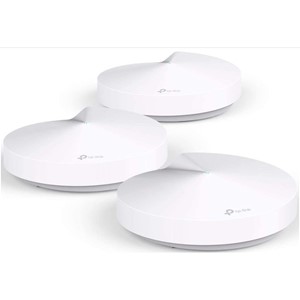
TP-Link Deco M5 WiFi Router
TP-Link Deco M5 Mesh Router
The Deco M5 offers speeds up to 1300Mbps and an area coverage up to 5,500 square feet. Which is great for large homes. It allows connection up to 100 devices. It’s dual-band, works with Alexa, has parental controls, and guest WiFi network. It is easy to setup and install.
Key Features
- Coverage area 5,500 Sq. Ft.
- Connect up to 100 devices
- Dual-band 2.4GHz & 5GHz
- Parental controls
- 3-Years Built-in antivirus

TP-Link Deco M5 Whole Home WiFi System
Read Customer Reviews
PROS
- Robust Parental Controls & QoS
- Easy Setup and Installation
- Automatically Chooses Fastest Path for Every Device
- Buffer-Free 4K Streaming
CONS
- Price
- Some Were Disappointed In Performance
Deco M5 protects your personal data and every connected device from online threats like viruses and malware. The system also makes it easy to customize WiFi access for guests and family.
–
Best Value
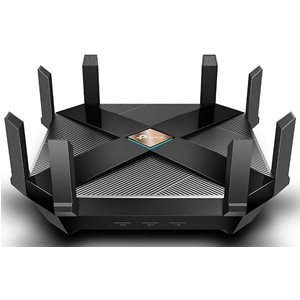
TP-Link AX6000 WiFi Router
TP-Link AX6000 WiFi 6 Router
This router has speeds of 4804Mbps on the 5GHz band and 1148Mbps on the 2.4GHz band. You have a 2.5Gbps WAN port, and, works with Alexa, has parental controls, and guest WiFi network. It is easy to setup and install. The high speed WiFi 6 router also works with Alexa.
Key Features
- 8 gigabit Ethernet ports
- Type A & C USB 3.0 ports
- Dual-band 2.4GHz & 5GHz
- 8 High gain antennas
- Parental controls with profiles
- 1.8 GHz Quad Core CPU

TP-Link AX6000 WiFi 6 Router
Read Customer Reviews
PROS
- Delivers wireless speed up to 5952Mbps
- Easy Setup and Installation
- Uses OFDMA and AX MU-MIMO technology
- Active content filtering
- Powerful real-time antivirus
CONS
- Price
- HomeCare features require a paid subscription
- Poor customer service
The TP-Link AX6000 is compatible with existing WiFi devices and new WiFi 6 devices like Galaxy Note 10, Galaxy S10, iPhone 11 series. The Archer AX6000 router will support your growing need for WiFi whether you’re streaming 4k/8k movies, online gaming, experiencing VR, or engaging with your smart devices.
–
Best Coverage
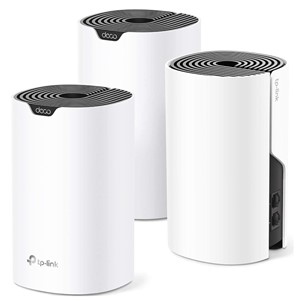
Deco S4 Whole Home Mesh WiFi Router
TP-Link Deco S4 Mesh WiFi Router
This whole home mesh router offers coverage up to 5,500 square feet and is ideal for large homes. Has speeds of 867Mbps on the 5GHz band and 300Mbps on the 2.4GHz band. You can connect up to 100 devices on the network. It also works with Alexa.
Key Features
- Supports port forwarding
- Works with Amazon’s Alexa
- Dual-band 2.4GHz & 5GHz
- Coverage area up to 5,500 Sq. Ft.
- One name and one password to setup network
- Turn on/off guest WiFi with Alexa voice commands

TP-Link Deco S4 Mesh Router
Read Customer Reviews
PROS
- Delivers wireless speed up to 1200Mbps
- Easy Setup and Installation
- Connect up to 100 devices
- Control your WiFi while at home or away using the Deco app
- Automatically finds the best path and connection for every device
CONS
- Price
- Some reported connection issues
- Poor customer service
This model provides a large coverage area that is great for large homes or areas that require a strong WiFi signal.
–
Best Budget Buy
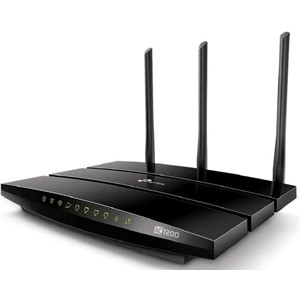
TP-Link AC1200 Gigabit Smart WiFi Router
TP-Link AC1200 WiFi Router
This budget model offers coverage between 2,000 to 3,000 square feet and allows connections up to 14 devices. Has speeds of 900Mbps on the 5GHz band and 300Mbps on the 2.4GHz band. Set up and manage your home network at home or remotely using the TP-Link Tether app. Great for small to medium size homes.
Key Features
- 4 gigabit Ethernet ports
- Supports all smart devices
- Dual-band 2.4GHz & 5GHz
- Coverage area up to 3,000 Sq. Ft.
- Parental controls and guest WiFi

TP-Link AC1200 Gigabit WiFi Smart Router
Read Customer Reviews
PROS
- Delivers wireless speed up to 1200Mbps
- Easy Setup and Installation
- Connect up to 14 devices
- Control your WiFi while at home or away using the Deco app
CONS
- Does not support WDS & WISP
- Some reported connection issues
This affordable model provides good signal strength, extends coverage area and good WiFi speeds on both the 2.4GHz and 5GHz bands.
–
Best Large Homes
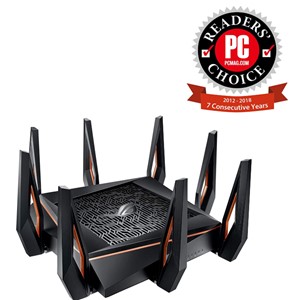
ASUS ROG Rapture GT-AX11000 Router
ASUS ROG Rapture GT-AX11000 WiFi Router
This tri-band WiFi router offers coverage up to 5,000 square feet. Has speeds of 4804Mbps on the 5GHz band, 4804 on 5GHz band, and 1148Mbps on the 2.4GHz band that totals 10 Gbps. The Tri-Band Wi-Fi 6 supports 802.11ax standard, OFDMA, beamforming, MU-MIMO, 1024QAM, 8 External Antennas, 160 Mhz bandwidth, DFS Bands and also supports Ai-Mesh.
Key Features
- 4 gigabit LAN ports
- 1 Gig WAN port
- 2 USB 3.0 ports
- Tri-Band (1) 2.4 GHz (2) 5GHz bands
- 1 2.5GB LAN port for gaming
- Advanced parental controls

ASUS ROG Rapture GT-AX11000 WiFi Router
Read Customer Reviews
PROS
- Delivers wireless speed up to 10Gbps
- Easy Setup and Installation
- 1.8GHz Quad Core CPU
- 256MB Flash, 1GB RAM
- Lifetime security by Trend Micro
- Powerful whole home WiFi system
CONS
- Price
- Some reported WiFi connection issues
This model provides great performance for gamers. It comes with a dedicated 5G gaming band along with game packet prioritization and game boost.
–
Best For Gamers

TP-Link AC5400 Tri Band Gaming Router
TP-Link AC5400 Tri Band Gaming Router
This tri-band WiFi router offers coverage up to 5,000 square feet. Has speeds of 4804Mbps on the 5GHz band, 4804 on 5GHz band, and 1148Mbps on the 2.4GHz band that totals 10 Gbps. The Tri-Band Wi-Fi 6 supports 802.11ax standard, OFDMA, beamforming, MU-MIMO, 1024QAM, 8 External Antennas, 160 Mhz bandwidth, DFS Bands and also supports Ai-Mesh.
Key Features
- 8 gigabit LAN ports
- 1 Gigabit WAN port
- 2 USB 3.0 ports
- Supports Amazon Alexa
- Tri-Band 2.4GHz at 1000Mbps & 2 5GHz at 2167Mbps bands
- Allows you to set bandwidth priority
- Ling aggregation & airtime fairness

TP-Link AC5400 Gaming Router
Read Customer Reviews
PROS
- Delivers wireless speed up to 5334Mbps
- Easy Setup and Installation
- 1.8GHz 64-bit Quad Core CPU
- 256MB Flash, 1GB RAM
- 8 high performance antennas
- 4 x 4 MU-MIMO
CONS
- Price
- Poor customer service
RangeBoost strengthens reception and Beamforming sends targeted Wi-Fi to keep devices connected at farther distances than other wireless internet routers. Dynamic optimization prioritizes traffic to eradicate latency.
–
Best Cybersecurity Router
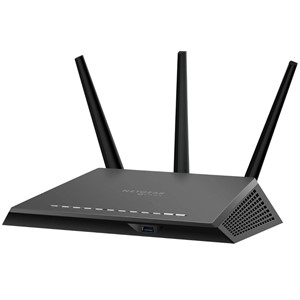
NETGEAR Nighthawk Smart WiFi Router (RS400)
NETGEAR Nighthawk Smart WiFi Router (RS400)
This dual band router comes with 3-years of Armor security. Allows connections of 35 devices and has a coverage area up to 2,000 square feet. Has speeds of 1625Mbps on the 5GHz band and 600Mbps on the 2.4GHz band that totals 2300Mbps.
Key Features
- 4 gigabit LAN ports
- Includes Guest WiFi access, DoS, Firewall & VPN
- 2 (1) USB 3.0 & (1) 2.0 ports
- Works with Amazon Alexa
- Dual band 2.4GHz and 5GHz bands
- 3-years advanced Armor Cyber-Security

NETGEAR Nighthawk RS400 Router
Read Customer Reviews
PROS
- Delivers wireless speed up to 2300Mbps
- Easy to setup and install
- 1GHz dual core processor
- Beamforming, MU-MIMO, Dynamic QoS, & Smart Connect
- 3 high performance antennas
- Supports WPA2 wireless security protocols
CONS
- Price
- Smart parental controls free for 1st month and $4.99 thereafter
This specific router was made for gamers. Lots of features that takes the gaming experience to the next level.
–
Best Mesh System
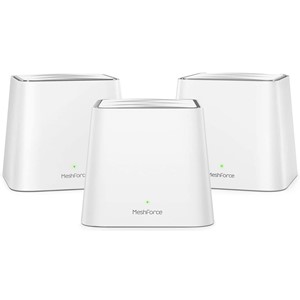
Meshforce M3S WiFi Mesh System
Meshforce M3S Home Mesh System
This high performance dual mesh router has coverage up to 6,000 square feet. It will allow up to 60 devices to be connected to the network. Has speeds on the 5GHz 802.11ac band 867Mbps and on the 2.4GHz 802.11n/g/b band 300Mbps. Great coverage for large homes.
Key Features
- Set up the network using one SSID
- Helps in eliminating dead zones
- Create isolated guest WiFi zone
- Encrypted with high-level WPA2-PSK wireless security
- Specify children’s access to the internet
- Supports PPPOE, Dynamic IP, Static IP, Bridge Mode

Meshforce M3S Home WiFi System
Read Customer Reviews
PROS
- Delivers wireless speed up to 2300Mbps
- Easy setup and installation
- Remote management for entire network
- Additional dots can be added to extend coverage
- Manage WiFi remotely using mobile device
- Initial coverage area up to 6,000 Sq. Ft.
CONS
- Price
- Some users complained about slower speeds than advertised
If you are looking for a way to take your internet to the level, then this mesh system is for you. Great coverage and WiFi signal in every area of the house. Uses one SSID to set-up the entire network.
–
Best Google Home
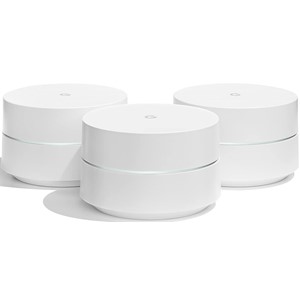
Google WiFi Mesh Home System
Meshforce M3S Home Mesh System
This dual-band mesh router has coverage up to 4,500 square feet and can expand to 9,000 sq. ft. using additional point units. It will allow up to 50+ devices to be connected to the network. Has speeds on the 5GHz 802.11ac band 867Mbps and on the 2.4GHz 802.11n/g/b band 300Mbps. Great coverage for large homes and business areas.
Key Features
- Supports IEEE 802.11a/b/g/n/ac
- Works with Google Assistant
- Family WiFi controls
- Helps in eliminating dead zone areas
- Compatible with major internet service providers
- 2 Gigabit Ethernet ports per point

Meshforce M3S Home WiFi System
Read Customer Reviews
PROS
- Easy setup and installation using Google app
- Remote management for entire network
- Additional points can be added to extend coverage
- Manage WiFi remotely using mobile device
- Initial coverage area up to 4,500 Sq. Ft.
CONS
- Price
- No VPN install capabilities
- Family Wifi and network monitoring only works with cloud services turned on
Each Google dual band point covers 1500 square feet. This mesh system allows room for growth as your WiFi needs increase.
–
Best Amazon Alexa Home
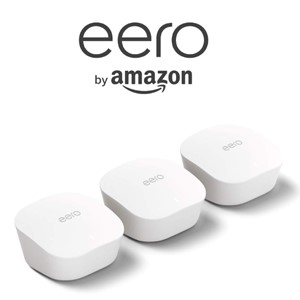
Amazon WiFi Mesh Home System
Amazon eero WiFi Mesh Home System
This dual-band mesh router has coverage up to 5,000 square feet with speeds up to 350Mbps based on distance from the nearest eero unit. It will allow up to 128 devices to be connected to the network. Great coverage for large homes and business areas.
Key Features
- Uses TrueMesh technology
- Works with existing internet service provider and modem
- Voice control with Amazon Alexa
- Easily manage devices and individuals with Alexa
- The eero app allows you to see what’s happening on the network
- 2 Ethernet ports per device

Amazon eero Home WiFi System
Read Customer Reviews
PROS
- Easy setup and installation within 10 minutes
- Remote management for entire network
- Say goodbye to dead spots and buffering
- Dual-band 2.4GHz & 5GHz bands
CONS
- Price
- Some reported connection gets dropped
This mesh system comes with three units each covering 1500 square feet. Provides room for expansion and offers streaming, gaming and work anywhere in your home.
Why Use A Router
Routers are useful for providing traffic using a gateway to the internet and other networks using a computer or other devices. Home users generally want a good way to use the internet without having to connect lots of wires. This is the benefit of using wireless routers. The best rated Wi-Fi routers will sort through the good from the bad and leave the top rated ones for your consideration.
Routers have a dual or some have a tri-band capabilities. The wireless units have longer and better ranges. Provide specialty features and easy access to the internet without those wires.
Some of these routers provide signal coverage for the entire house which takes care of those dead zones. Along with that, increased Wi-Fi speeds make downloading and uploading data and playing games a breeze. These are just some of the features these routers offer.
Advantages of a Router
Below are some of the few advantages a router can offer:
- Allows you to move freely within the network area using a laptop or handheld devices
- Share files and other resources with other devices connected to the network
- Easy to add extra devices to the network
- Easy to add additional components to the network
- VOIP is available with wireless networks
- Access points can be used to boost the signal range if needed
- Transferring data to social media is easier
Disadvantages of Routers
Just as there are advantages of routers, below are some of the disadvantages:
- Wireless connections can be obstructed by household items such as structures like ceilings, walls and furniture
- They are more expensive than extenders or adapters
- The speed of a wireless router is slower than a wired one
- The further away you are from the router the signal gets worse
- Jamming and interference may also increase
Wireless Test Results and Variations Explained
Some users may experience slower speeds than advertised by the manufacture of a specific router. Or, the coverage area is not measuring up. Please take some time to read the information below. It will explain some of the reasons why you may experience some variations of speed or coverage. Also, manufactures test their units in a lab where there are no obstructions. This gives them a score for their router. They are averaged and that number gets printed on the outside of the package.
Actual wireless transmission rates, wireless coverage, and number of connected devices are not guaranteed, and will vary as a result of the following:
- Environmental factors, that includes building materials, physical objects and obstacles.
- Network conditions, including local interference, volume and density of traffic, product location, network complexity, and network overhead.
- Cordless phones, baby monitors and microwaves.
- Interference from other WiFi routers or modems.
- Some devices may not accept advanced WiFi speeds
- You may need to reboot the system. When rebooting do it in the following order: Modem, Router, Computer, WiFi devices.
- You may have one or more devices that is hogging all of the available bandwidth
- Too many devices connected to the network and the bandwidth cannot handle it. Shut some of them down to see if the WiFi speed increases.
Shop Additional Routers
In the list above, we selected the best of the best. However, there are some other great options to choose from. Take a look.
Buying Guide For Wireless Routers
The biggest concern people have is getting the WiFi signal from the existing router to reach all the areas of the home. As more and more gadgets are being created and used, some of the bandwidth of the current router may not be sufficient to handle the load. This buying guide for wireless routers will come in handy.
The buying guide will assist you in deciding which features your router should have as you read through each of the topics being covered. Or, at least the ones you will need. Then, look for a router that’s affordable and provides most of them.
You may have experienced slowdowns and dead zones in some area of your home. This is where your WiFi network may need to be upgraded to a newer router or even a mesh network.
This buying guide will assist you in your search for a router and what to look for.
Buying Guide Table of Topics
- Test Your Internet Speed
- Getting A Faster Internet
- Buy More Bandwidth from Your Service Provider
- How Can I Get More Coverage?
- Expand Coverage Using A Mesh Network
- Look For Special Features
- WiFi 6 Features
- App & Voice Control
- How To Keep Data Safe?
- Protecting Your Family Online
- Wired Connections
- Final Tips
- Shop Routers
Test Your Internet Speed
Your service provider offers plans for the internet. You pay for the speed they offer you. You selected a router that can handle the traffic but may not experience or get full performance as they promised. Testing will verify this is the case.
Testing will also give you a benchmark to compare against with other routers. When testing, test at different locations throughout your home and note the areas where the signal is strong and areas where it’s weakest. Also note the areas where it’s needed most. You may also discover some dead zones where there is no signal at all. Note those as well. Make a note of the upload and download speeds in each area.
You can click on the following link to test your internet speed.
Jot down the results in each of the areas you need internet access. Your goal is to get a router that will increase the signal equally throughout the home and especially in the areas where it is needed the most. Even in the dead zones you may have discovered.
When you have installed your new router, test the internet speeds in the same areas and see if the newer model actually improves speed and provides a signal in the dead zone areas. If yes, you made a good choice. If no, return it and select another router model.
Note: Before purchasing, ask the manufacture or clerk is there a return policy and what must be done to secure a full refund if the router does not measure up.
Getting A Faster Internet
After the testing step, you are ready for getting a faster internet.
Some cable companies offer renting a router from them. The downside of this is, rentals are often older and slower and may not handle the traffic your household demands. What you are looking for is a router that offers a higher speed internet and you won’t be paying those monthly fees.
Many of these newer routers offer dual and even tri-band models. Some can process up to millions of instructions per second. This offers the network to manage traffic to multiple devices. The dual band models handle 2.4GHz and 5GHz bands. The tri-band models offer the same two bands plus one additional 5GHz band. This type makes encountering a traffic jam less likely. The current fastest WiFi standard is WiFi 6 or 802.11ax. Currently, most routers have WiFi 5 or 802.11ac. Some may also have 802.11a/b/g/n on the 2.4GHz band.
A WiFi 5 router will be sufficient as most homes today run devices that are on the 802.11ac frequency. However, as time progresses, more and more new devices will be using the 802.11ax. So, if you can secure a router that supports WiFi 6, you will be in position to expand using new devices without having to purchase a new router.
Be sure to look for these models.
Note: If you should purchase a WiFi 6 router, your current WiFi 5 devices will work but not at the WiFi 6 speeds. Only a WiFi 6 device can utilize those higher speeds.
Buy More Bandwidth From Your Service Provider
Before you go out spending money on a new router, you can check with your service provider if they offer higher tiers than the one you are currently on. If the answer is yes, ask if your current router can handle the bandwidth they will be sending you. This will alert you if you need to buy a router for the bandwidth you are considering to purchase.
It’s is possible your current bandwidth was purchased because of your budget. Now, you notice that this tier is not cutting it because of the increased traffic and devices you are now using. You may want to consider buying that new level of service.
You are probably aware that high-resolution video is a huge bandwidth hog. High-resolution video is one of the biggest bandwidth hogs, so we use that as a general guide when choosing a service tier.
On the Netflix customer help page they suggest that you need at least 5 Mbps to view HD content. To me, streaming at today’s high-resolution content, you should consider doubling it to 10 Mbps. For 4K UltraHD streaming you need 25 Mbps. The bottom line here is to choose the service level accordingly.
Assuming your current router can handle the new service level, you should be OK. However, if not, be sure to find a router that supports the new service level you will be receiving from the service provider.
How Can I Increase My Coverage?
Generally, a router generates a sphere of WiFi when conditions are ideal. However, this sphere can be interrupted by walls and floors and other objects in the home or apartment. On the edges of the signal, you may not experience a solid connection or even none at all. The bottom line is, you have plenty of speed, but it’s not getting to the areas where it’s needed most.
Today’s WiFi routers have two or more high-performance antennas that can broadcast a signal from the modem into the air. Some routers have more antennas that can produce a wider coverage. They can be aimed, or moved, toward areas of need and this is known as beamforming. This creates a directional signal that funnels more WiFi where it’s needed.
When looking over the different routers, look for the beamforming feature. As this may help in the areas where the signal is currently the weakest.
Expand Coverage Using A Mesh Network
Another way to expand coverage is using a mesh network. In large homes, the signal can get weak or even drop the signal altogether. This creates areas known as “dead zones”.
A mesh router system uses multiple routers or nodes to create a wireless mesh that covers your home’s layout. The nodes are placed in different areas of the home that expands the WiFi signal coverage.
This flexibility allows you to blanket WiFi coverage that can go vertical to cover each floor of the house and horizontally to cover a garage or patio. This whole network is setup using a single WiFi name (SSID) so you can experience seamless connectivity as you roam around the house or from floor to floor.
As you can see, you have lots of flexibility to lay a blanket of WiFi where it’s needed and experience no loss of connectivity.
Of course, these mesh systems are expensive and may be out of your budget range. Don’t give up. There is another method you can use and it’s a WiFi extender. These are generally much cheaper and more affordable. They pick up a weak signal and amplify it to where it’s needed most. You might want to consider using this method to extend WiFi coverage. Especially if you cannot afford the mesh systems.
Look For Special Features
As you review routers it’s important to look over the special features it has that will also improve your WiFi experience.
Now that you have followed the steps above, it’s time for your router to start working smart. Each model router will have different features. Look over these features and decide which ones are needed for your network.
Below are some of the features you should look for in a router:
- MU-MIMO – This is known as Multi-User, Multiple-Input, and Multiple-Output. This feature improves WiFi performance in homes with multiple users. This is the case with most households. This should be the #1 feature to look for when considering purchasing a new router.
- Airtime Fairness – This steers more bandwidth to newer devices that meet the latest standard 802.11ax, so older, slower devices won’t slow down streaming of high-resolution content.
- Device Prioritization – This feature allows you to decide which device needs more bandwidth at any given point in the day. Think work and school computers in the daytime, movie and TV streaming devices in the evening.
- Online Gaming – Some routers are optimized for gaming. If you are stuck inside, like most of us, this may be a feature to consider. These models come with customized dashboards and features that help minimize lag which makes gaming more enjoyable.
Wi-Fi 6 Features
As new devices are being created or upgrades of this technology are added to existing devices, you may need to consider WiFi 6 features. More and more new routers offer WiFi 6 technology based on WiFi 6 standards.
Let’s look at some of these features.
- Orthogonal Frequency-Division Multiple Access (OFDMA) – This feature increases the network capacity and efficiency through smarter traffic scheduling. It allows an AP (Access Point) to allocate the whole channel to a single user at a time or partition a channel to serve multiple users simultaneously.
- Basic Service Set (BSS) – This technology eliminates interference from nearby WiFi networks. This is huge in dense neighborhoods and apartment complexes with a sudden increase in teleworking users.
As you review the WiFi 6 routers, look for the above features. They will be important as more and more devices get the WiFi 6 technology.
App and Voice Control
The special features mentioned above are settings that are controlled by the router’s companion app. Take notice of how the app is installed and accessed. It may be browser-based or, downloaded to your phone or tablet. Whether is browser-based or downloaded to a phone or tablet, make sure it’s compatible with your device’s operating system. Otherwise the router will not work.
Take note that some apps offer tier-based system in which some functions are free, while the more robust controls and protections are subscription-based. Before making any commitment be sure you know if there will be additional fees for the features you want. You will need to include these into your budget.
Some of the new routers on the market today are common to accept voice commands from Amazon Alexa and Google Assistant. This is a great feature to have when you need to update settings for individuals or setting up a guest network.
How To Keep Data Safe?
Another area of concern is how well the new router protects data. You should be concerned about privacy when beaming personal and business information through the air. Today’s advanced routers do offer some layers of protection that may ease your concerns.
Most routers will have a feature called WiFi Protected Access or WPA. This is the current protocol for securing wireless networks. Some routers may also have the ultra-secure WPA2 capability. Be sure the model you select has one or both of these protocols.
Some routers also offer customizable firewall protection, which helps keep out spyware, malware and viruses.
The DoS (denial-of-service) attack can slow or even terminate the network connection. Some routers offer this protection. Be sure the router you select has this feature.
Another great feature to keep data safe is creating a separate WiFi guest access to your WiFi network. This allows the guests not to get into the network using your password or peeking at your personal files.
Lastly, for added peace of mind, some routers offer ad-blockers and active threat scanning to preemptively identify dangerous sites.
Minimally, look for WPA or WPA2 feature on the router. Any of the others is a plus if they come with the router at no added expense.
Protecting Your Family Online
Individuals born in the past couple of decades have had access to the internet. Trying to social distance in our current environment makes this very difficult. Schoolwork and play can get blurred and trying to control these activities becomes even harder.
Some router apps offer flexible options that is designed for parents who want to manage their children’s online WiFi access time. At the same time, protect them from those bad actors out there.
The app that comes with the router will provide some useful parental controls to help you with this issue.
Most apps have some of the following parental controls:
- A family-safe browsing mode to tag and block sites that may contain violent, illegal, or adult content
- Restrict internet access for specific devices
- Limit the time they are on the internet and shut down access during the homework hours and bedtime
- Provide age-appropriate category blockers that are customized for each child
Please Note: Some of these features may be part of a subscription-based plan. If this is the case, be sure to budget this item for your kids’ safety when choosing a router. Some may offer these features during a free trial period and require a subscription when the free trial period is over. Check all this out before making a commitment to purchase.
Wired Connections
The last category to consider are wired connections. If you are planning on using the WiFi network for gaming platforms, personal computers, and connection to TVs, having a secure wired connection is a must.
If you take a look at your current router, you may see some Ethernet ports on the back. Some even have one or more USB ports.
Having this option can be important so that you can connect the Ethernet cord from the device directly into the router for the fastest connection and speed.
Some of these routers come with expansion hubs where you can place them in other areas of the home without dropping the WiFi access signal and speed. This allows you to add additional devices in those areas like a second TV or computer.
Some offer one or more USB ports which allows you to connect thumb drives and external devices like a printer as well.
Final Tips
We have taken the time to provide you with the ten best routers for specific conditions. You can look those over to determine if any these will provide the solution you are looking for.
If not, we have also included some additional routers that did not make our top ten. However, these are also highly rated and may do the job.
Ultimately, you will make the decision on which router is best for your situation. Each person’s situation will be different. That is why we offer a selection of different types of routers to consider.
Remember, get the router that provides the most features you really need. It’s great to get them all, but, your budget will have the final say here. As some of these options are expensive. Buy only what you can afford now. You can always expand or upgrade later.
As we mentioned before, some routers will come with WiFi 6 technology. Your existing WiFi 5 devices will work on the router but not at the WiFi 6 speeds. As time moves on, more and more devices will be WiFi 6 compatible. By having a WiFi 6 router, you will be ready for this technology without having to purchase a new one.
Go back to the Pros Cons Shopping home page.








